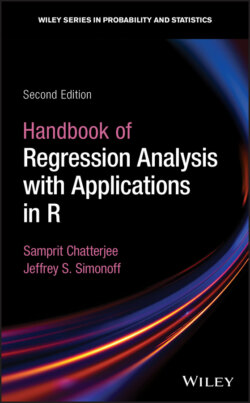Читать книгу Handbook of Regression Analysis With Applications in R - Samprit Chatterjee - Страница 2
Table of Contents
Оглавление1 Cover
2 Preface to the Second Edition
3 Preface to the First Edition How to Use This Book
4 PART ONE: The Multiple Linear Regression Model CHAPTER ONE: Multiple Linear Regression 1.1 Introduction 1.2 Concepts and Background Material 1.3 Methodology 1.4 Example — Estimating Home Prices 1.5 Summary CHAPTER TWO: Model Building 2.1 Introduction 2.2 Concepts and Background Material 2.3 Methodology 2.4 Indicator Variables and Modeling Interactions 2.5 Summary
5 PART TWO: Addressing Violations of Assumptions CHAPTER THREE: Diagnostics for Unusual Observations 3.1 Introduction 3.2 Concepts and Background Material 3.3 Methodology 3.4 Example — Estimating Home Prices (continued) 3.5 Summary CHAPTER FOUR: Transformations and Linearizable Models 4.1 Introduction 4.2 Concepts and Background Material: The Log‐Log Model 4.3 Concepts and Background Material: Semilog Models 4.4 Example — Predicting Movie Grosses After One Week 4.5 Summary CHAPTER FIVE: Time Series Data and Autocorrelation 5.1 Introduction 5.2 Concepts and Background Material 5.3 Methodology: Identifying Autocorrelation 5.4 Methodology: Addressing Autocorrelation 5.5 Summary
6 PART THREE: Categorical Predictors CHAPTER SIX: Analysis of Variance 6.1 Introduction 6.2 Concepts and Background Material 6.3 Methodology 6.4 Example — DVD Sales of Movies 6.5 Higher‐Way ANOVA 6.6 Summary CHAPTER SEVEN: Analysis of Covariance 7.1 Introduction 7.2 Methodology 7.3 Example — International Grosses of Movies 7.4 Summary
7 PART FOUR: Non‐Gaussian Regression Models CHAPTER EIGHT: Logistic Regression 8.1 Introduction 8.2 Concepts and Background Material 8.3 Methodology 8.4 Example — Smoking and Mortality 8.5 Example — Modeling Bankruptcy 8.6 Summary CHAPTER NINE: Multinomial Regression 9.1 Introduction 9.2 Concepts and Background Material 9.3 Methodology 9.4 Example — City Bond Ratings 9.5 Summary CHAPTER TEN: Count Regression 10.1 Introduction 10.2 Concepts and Background Material 10.3 Methodology 10.4 Overdispersion and Negative Binomial Regression 10.5 Example — Unprovoked Shark Attacks in Florida 10.6 Other Count Regression Models 10.7 Poisson Regression and Weighted Least Squares 10.8 Summary CHAPTER ELEVEN: Models for Time‐to‐Event (Survival) Data 11.1 Introduction 11.2 Concepts and Background Material 11.3 Methodology 11.4 Example — The Survival of Broadway Shows (continued) 11.5 Left‐Truncated/Right‐Censored Data and Time‐Varying Covariates 11.6 Summary
8 PART FIVE: Other Regression Models CHAPTER TWELVE: Nonlinear Regression 12.1 Introduction 12.2 Concepts and Background Material 12.3 Methodology 12.4 Example — Michaelis‐Menten Enzyme Kinetics 12.5 Summary CHAPTER THIRTEEN: Models for Longitudinal and Nested Data 13.1 Introduction 13.2 Concepts and Background Material 13.3 Methodology 13.4 Example — Tumor Growth in a Cancer Study 13.5 Example — Unprovoked Shark Attacks in the United States 13.6 Summary CHAPTER FOURTEEN: Regularization Methods and Sparse Models 14.1 Introduction 14.2 Concepts and Background Material 14.3 Methodology 14.4 Example — Human Development Index 14.5 Summary
9 PART SIX: Nonparametric and Semiparametric Models CHAPTER FIFTEEN: Smoothing and Additive Models 15.1 Introduction 15.2 Concepts and Background Material 15.3 Methodology 15.4 Example — Prices of German Used Automobiles 15.5 Local and Penalized Likelihood Regression 15.6 Using Smoothing to Identify Interactions 15.7 Summary CHAPTER SIXTEEN: Tree‐Based Models 16.1 Introduction 16.2 Concepts and Background Material 16.3 Methodology 16.4 Examples 16.5 Trees for Other Types of Data 16.6 Summary
10 Bibliography
11 Index
